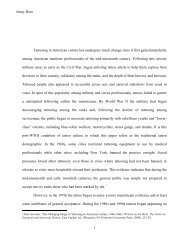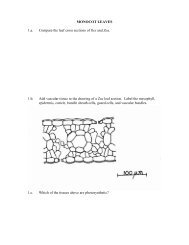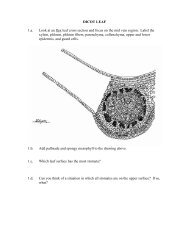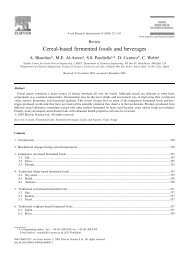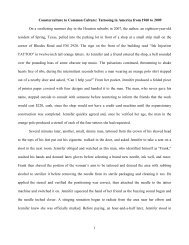Meat - Facing the Dilemmas
Meat - Facing the Dilemmas
Meat - Facing the Dilemmas
You also want an ePaper? Increase the reach of your titles
YUMPU automatically turns print PDFs into web optimized ePapers that Google loves.
<strong>Meat</strong>: <strong>the</strong> challengeConsumersContraction and convergence is good for our healthTony McMichaelThe world is eating more and more meat, andmeat production is contributing increasingly toglobal greenhouse gas emissions. Both excessmeat consumption and a change in <strong>the</strong> globalclimate pose risks to human health.In 2006 <strong>the</strong> Food and Agricultural Organization(FAO) issued an important report, Livestock’slong shadow, drawing attention to <strong>the</strong> impact of<strong>the</strong> livestock production sector on <strong>the</strong> world’sclimate. The major contributor is entericmethane from ruminant (digastric) grazers –cattle, sheep and goats.Modern humans come from a long line ofmeat-eaters, starting from around two millionyears ago. The widely-accepted ‘expensivetissue hypo<strong>the</strong>sis’ argues that <strong>the</strong> introductionof meat into <strong>the</strong> ancestral human diet lessened<strong>the</strong> need for a large and heavy-duty intestinefor digestion and fermentation of plant foods.The gut is a metabolically expensive organ torun. Hence, this dietary shift released preciousenergy that could, via <strong>the</strong> ‘experiments’ ofnatural selection, be reapplied to ano<strong>the</strong>r veryenergy-intensive organ, <strong>the</strong> brain. The earlyhuman gut thus contracted and <strong>the</strong> brainexpanded.That brain subsequently powered <strong>the</strong> evolutionof human culture, including <strong>the</strong> capacity toreshape and exploit diverse environmentsaround <strong>the</strong> world. Eventually farming emerged,livestock were domesticated, food suppliesexpanded and human populations grew. Thosetrends continued over ensuing centuries, andhave accelerated dramatically in recent times.Globally, both total population size and totalextrasomatic energy use, mostly from fossilfuels, have increased about fourfold since1900.As wealth has accrued and food productionhas become increasingly mechanised, so unitcosts have declined and consumer preferenceshave ‘risen’. Today’s uptrend is for a one-thirdincrease in total meat consumption in <strong>the</strong>world by mid-century. FAO argues that this isnot a sustainable trajectory. Ei<strong>the</strong>r our meatproduction methods must change radically orconsumption levels must decline. Or both.So, <strong>the</strong> wheel has come full circle. The ancientdietary shift that boosted our cerebral capacityhas led to a crowded and wealthier modernworld in which <strong>the</strong>re are too many of us wantingto eat too much meat, mostly from ruminants.Hence <strong>the</strong> now-substantial contribution of <strong>the</strong>livestock sector to global total greenhouse gasemissions. Estimates by both <strong>the</strong> UK SternReport and <strong>the</strong> FAO indicate that this sectorcontributes around one-fifth of total globalemissions. Methane from <strong>the</strong> ruminant gut isa problem because, molecule for molecule, itcauses much more warming than <strong>the</strong> betterknowngreenhouse gas, carbon dioxide.Nutrition scientists recommend an individualintake of around 50-100 grams of meat per day,to enhance <strong>the</strong> diet and to provide sufficientiron and vitamin B12. The high-income worldis, on average, now way above that level, beingwithin <strong>the</strong> range of 200-300 grams per day. TheUS has <strong>the</strong> highest per-person daily intake. Incontrast, <strong>the</strong> average intake in Sub-SaharanAfrica is around one eighth of that Americanlevel.As a world community, we must now consider<strong>the</strong> various facets of this environmental andpublic health dilemma:<strong>Meat</strong> consumption is now rising rapidly inmany parts of <strong>the</strong> world.There are great differences, at <strong>the</strong> moment,in per-person levels of meat consumption –some of this reflects cultural preference, somereflects access and affordability. The latterrepresents a moral challenge in inequity.The livestock sector is contributing asubstantial (though under-recognised)proportion of global greenhouse gasemissions.There is moderately persuasiveepidemiological evidence that <strong>the</strong> risk of largebowel cancer increases at higher levels of redmeat consumption. The risks of breast cancerand of obesity and heart disease may also beincreased, especially in relation to <strong>the</strong> high fatcontent of meat from intensively producedlivestock. The World Cancer Research Fund’scomprehensive report on Food, nutrition,physical activity and <strong>the</strong> prevention of cancerexamines this evidence thoroughly.1In a recent paper in The Lancet we proposethat <strong>the</strong> world should commit to reducing <strong>the</strong>global average daily intake of meat, especiallyred meat from ruminants.2 This would be partof <strong>the</strong> evolving portfolio strategy – acrossvarious sectors of commerce, energy use andhuman behaviour – to mitigate climate change.The fairest approach is ‘contraction andconvergence’, where <strong>the</strong> world’s nations agree toreduce average per-person meat consumption(currently just over 100 grams per day) and todo so equitably. High-consuming populationswould reduce <strong>the</strong>ir intake and low-consumingpopulations could increase <strong>the</strong>ir intake up to<strong>the</strong> agreed average level.To avoid an increasing contribution to globalwarming from <strong>the</strong> livestock sector, werecommend a global average target figure of 90grams of meat per day – with not more than 50grams from ruminant animals. Indeed, manypopulations have potential access to o<strong>the</strong>r,often healthier, sources of meat; in Australiait would be good for <strong>the</strong> environment andfor <strong>the</strong> nation’s health to eat more kangaroomeat, which is lean and contains omega-3 fattyacids.This would be a win-win strategy. Globalwarming would be slowed. Health risks wouldbe reduced in high-consuming populations,and <strong>the</strong>re would be gains in nutritional statusin lower-income countries where deficienciesof iron, protein and energy in <strong>the</strong> diet wouldbe reduced, conferring particular benefits onchild health and development. Any increasesin cancer, heart disease or obesity-relateddiabetes in those lower-income countrieswould be limited by <strong>the</strong> ceiling intake figure of90 grams/day.Phased in over several decades, this would begood for <strong>the</strong> planet, for global equity and forpopulation health.Professor Tony McMichael is anepidemiologist at <strong>the</strong> AustralianNational University, Canberra.His particular interest is studyingenvironmental influences onpopulation health, especially today’slarger-scale influences from climatechange, food systems and <strong>the</strong>urban environment.1 WCRF/AICR (2007) Food, nutrition, physical activity, and<strong>the</strong> prevention of cancer. www.dietandcancerreport.org2 McMichael AJ, Powles JW, Butler CD, Uauy R. (2007)Food, livestock production, energy, climate change, andhealth.The Lancet, September 13.www.foodethicscouncil.org | Volume 2 Issue 4 | Winter 2007 05




